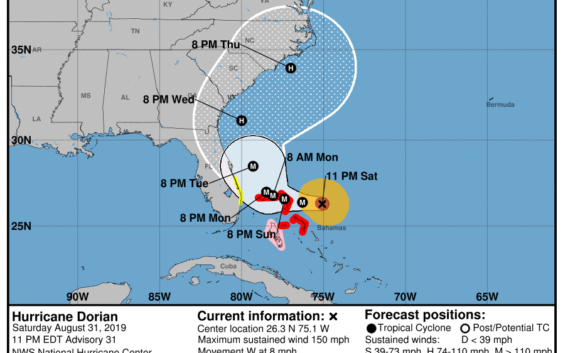- Couple accused of creating videos of young girls using hidden cameras at The Woodlands Mall, Hurricane Harbor
- Couple accused of creating videos with hidden cameras at The Woodlands Mall, Hurricane Harbor
- The Texanist: Texas Gets More Tornadoes Than Any Other State, but Don’t Freak Out
- U.S. Supreme Court says Texans can sue state for flood damage
- This is how many hurricanes NC State researchers predict this year
8 a.m. update: Hurricane Dorian strengthens with potential trek to Wilmington area

Gov. Roy Cooper signs official state of emergency declaration for North Carolina as latest NHC track shows storm moving toward Southeastern North Carolina by Thursday
WILMINGTON — Southeastern North Carolina got a sense of deja vu Saturday as the region found itself inside the dreaded cone of uncertainty for Hurricane Dorian.
By 11 p.m. Saturday, winds from the Category 4 storm had increased to 150 mph and the National Hurricane Center’s latest update put the eye of the storm just south of the Carolina coast around 8 p.m. Thursday. That projection would delay Dorian’s arrival from previous forecasts.
As of the 11 p.m. update, the storm was still moving west at 8 mph, slowing for the next couple days before a gradual turn to the northwest. A hurricane warning was announced for the northwestern Bahamas, with tropical storm winds beginning Saturday night. Tropical storm winds could arrive in Southeastern North Carolina by Tuesday night.
However, with such drastic changes in the track of the storm over the past few days, the National Weather Service’s Wilmington office is cautioning local residents not to panic, but to be vigilant.
“The track will definitely continue to change, but to what degree we don’t know,” meteorologist Jordan Baker said Saturday afternoon. “It’s been changing so much, and we still have a lot to go. But we want people to have a plan now, so if we get closer and there looks like there could be impacts, you will be ready.”
Pender County Emergency Management said Saturday residents should use the weekend to prepare in case the storm does impact the area.
“This is the time to prepare,” said Tom Collins, Pender County Emergency Manager. “We could possibly experience high winds, rainfall, storm surge and flooding by Thursday.”
At area gas stations, it was hard to tell whether the long lines were for Labor Day traffic or the early signs of hurricane prep. But at grocery stores, the preparation for Dorian were clearly underway. Some people reported shelves cleared of water, while area Food Lions had already put out dozens of extra cases.
Gov. Roy Cooper officially declared a state of emergency for North Carolina on Saturday night. On Friday, he had allowed certain restrictions to be waived in order to help farmers and support relief efforts in advance of the storm. With Saturday’s early forecast, he expanded the order to ensure critically needed items like fuel, water and food can be distributed should the state be affected by the storm.
“Now is the time to prepare and take Dorian seriously,” Cooper said in a release. “This storm could cause serious damage and bring dangerous conditions to our state. I urge everyone to follow the forecast and listen to their local first responders.”
At 3 p.m. Friday, Brunswick County issued a statement citing the NWS’ immediate concerns as ongoing tidal/coastal flooding and the increased threat for rip currents during Labor Day weekend. Coastal North Carolina residents who hit the beaches for the long weekend should be on the lookout for rough surf and strengthening rip currents beginning Saturday.
University of North Carolina Wilmington announced Friday it was monitoring the storm but did not anticipate any closures or delays early next week.
Due to the high uncertainty of the storm’s path, coastal residents should prepare their hurricane kits now and continue to monitor the storm throughout the weekend.
How to prepare before a storm hits:
Necessities
Water. 1 gallon per person, per day, prepare for a minimum of three days. Battery-operated television or radio. Extra batteries Manual can opener Local maps Flashlights and waterproof matches Cellphone with chargers, inverter or solar charger Toilet paper Baby supplies Cash (ATMs may not work after the storm) Rain gear (including a hat) Bleach or water purification tablets Soap and detergent Moist towelettes, garbage bags and plastic ties for personal sanitation. Charcoal/lighter fluid or portable camping stove Disposable plates, glasses and utensils Ice chest and ice Valuable papers — insurance information, passports, Social Security cards, bank account and credit card numbers, wills, deeds, etc. — or copies, in a waterproof bag Prescription and other necessary medicines Blankets, tarp and masking tape Dust mask to filter contaminated air, plastic sheeting and duct tape. Three day’s worth of clothing, sleeping bags First-aid kit, aspirin or pain reliever, anti-diarrhea medication, scissors, tweezers, bug spray Feminine supplies and personal hygiene items Fire extinguisher — ABC type Extra pair of eyeglasses Extra house, car keys Tools: Shut-off wrench, pliers Needles, thread Whistle Signal flare Games,books for entertainment Petcare: leashes, pet carriers, food Sunscreen and sunglasses Food
Baby food, baby formula, powdered milk Canned meats (Spam, chicken, ham) Canned fish (tuna, sardines) Canned meals: spaghetti, soup, stew, chili Canned fruits and vegetables Cereal, crackers and cookies Instant coffee, tea bags, sodas, juice Granola bars, nuts, trail mix Peanut butter and jelly Sugar, salt, pepper Sources: American Red Cross; FEMA; N.C. Emergency Management